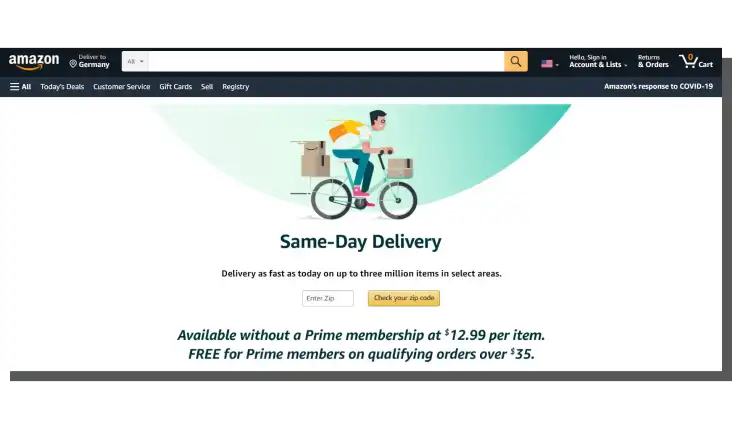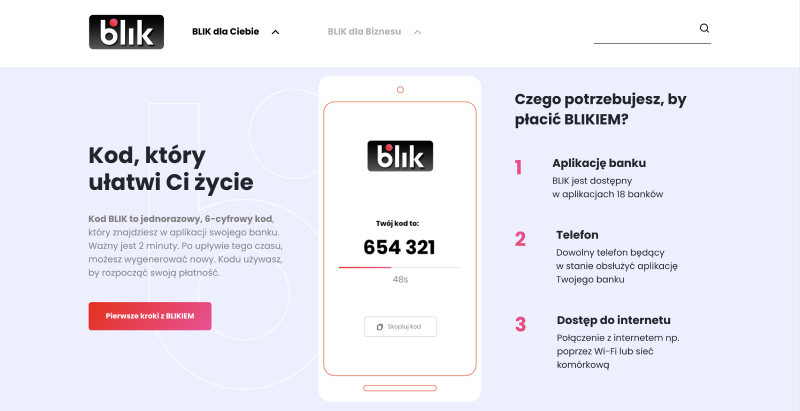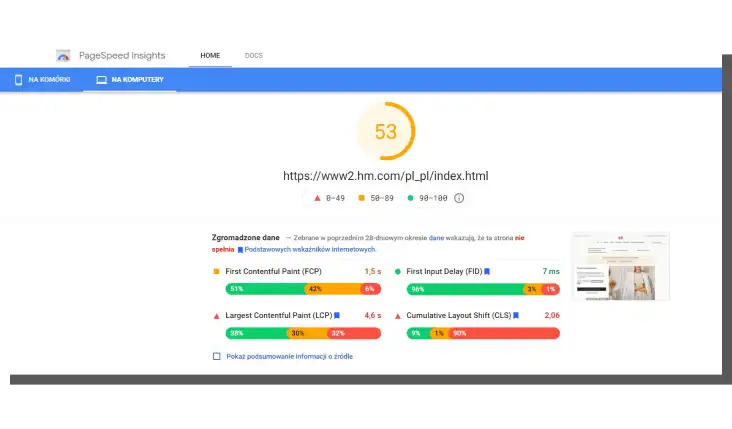You don't live in a vacuum. You don't need to be convinced of this. And if you don't live in a vacuum, then civilizational trends influence where you make purchases, from who you buy, what you buy, and how you buy.
And what's more, they control how you want to and can buy. And you want to buy immediately without losing even a second. Currently, that is the basis of user experience.
Today, purchases in E-Commerce are meant to resemble visits to pit stops and not visits to a mechanic who is available in three days.
Is it possible to buy in the spirit of immediacy? What do speed and immediacy mean in E-Commerce? Has the speed of order fulfillment surpassed the speed of sound? Are you able to buy and sell with the speed of light?
Please forgive us for these exaggerated metaphors. The matter is grave. Today, speed is one of the most important goals in determining a good user experience.
A trend in E-Commerce: The Age of Immediacy
Victor S. Yocco, the author of the widely discussed book "Design for the Mind. Seven Psychological Principles of Persuasive Design" has no doubts regarding immediacy.
Expectations of immediate gratification are common and concern almost every field of human activity.
In the case of digital products, it's even stronger and more common. In fact, it's hard not to agree with his observations.

Are people online non-stop? Yes. Isn't multi-device and multitasking mode their default mode? Are they no longer able to endure delays or even buffering when watching content on streaming platforms? These are rhetorical questions.
Ordering in an online store with same-day delivery, isn't that what people expect? They do it very openly and with a sense of the obviousness of such an expectation. Time and speed of:
- Order processing
- Execution of an operation
- Reaction of a system
- Availability of a system
are one of the most crucial features, standards, and expectations in E-Commerce.
It's worth remembering the words of Victor S. Yocco mentioned in the article "UX in the Age of Immediacy: Victor Yocco on Designing for Short Attention Spans." And he bluntly says how things stand.
People expect digital products to fulfill their needs in advance.
"Our products (not excluding online stores) should know us and accommodate our needs without much training or effort." These are the words of Victor S. Yocco. But probably most people will sign their name under this statement.
The wide world of digital products (apart from usability and convenience) is the root of overstimulation and the drastic shortening of attention span.
In practice, this means that the user, the E-Commerce customer, can focus on a product for a very short time.
Civilizational and cognitive conditions impose the consideration of these issues in the design of a positive user experience. The most prominent players in the market have discovered that speed in E-Commerce is understood as a fundamental value, essential goal, and primary way of competing.
The speed revolution that Amazon proposed has not only become a reality but a global standard.

The problem of immediacy, speed can be seen in all the most important elements, functionalities, and solutions.
Alright, that's enough of the theory. Let's get to the specifics.
Fast interface in E-Commerce
What does that even mean? Most often, we answer this question by using synonymous terms. Intuitive, simple, seamless, clear, convenient, helpful, or efficient. Designed with the needs, habits, and cognitive capabilities of online store customers in mind.
A fast interface in E-Commerce is an interface that allows users to:
- Complete tasks as fast as possible with as few actions as possible
- Achieve goals with as few mistakes as possible (made by users or system)
- Control the buying process
- Is functionally profiled to meet specific user needs
- Use the store on any device with any technical parameters (responsiveness)
- Avoid limitations regarding context, distractors (stimuli that distract users), and technical problems (e.g., problems with lack of signal or access to the Internet)
- Use the potential of every device (e.g., functionalities available on mobile devices or available space on desktop devices).

Fast purchasing process in E-Commerce
The need to speed up the purchase can also be seen in the double standard constantly developed in E-Commerce. Here we have in mind the following options:
- Buy as a Guest or Customer
- Standard or expedited purchase.
The desire for immediate purchases can also be observed in the trend of uniformity of category pages and product pages.

Another example is shortening access to a specific product through SEO tools and ads that redirect the customer to the home page or directly to the product page or category page.

Quick shopping also means supporting and respecting the work of the user and the capabilities of their working memory. And these are supported by solutions and functionalities, including the following:
- Ability to recover an abandoned shopping cart
- Adding products to the cart from the list of products
- Offering wishlists
- Providing a comparison function
- Precise filtering and sorting
- Automatic repeat purchases.
The user experience of an online store in the age of immediacy boils down to this to a large extent.
Fast Delivery 24h and quick returns in online stores
Immediacy and speed also depend on the delivery time. Same-day delivery, next-day delivery, not excluding public holidays and Christmas? Home delivery and delivery to a pick-up point (also the personal collection at the nearest stationary store) are standard today. They're a commitment for any online store.
The problem of fast delivery is often connected to issues with availability, stock levels, and speed of updating this information on product pages.
Updating data in real-time based on factual data and not marketing tricks related to unavailability rule is also an element of competing through speed.
The speed of delivery doesn't concern purely technical, logistical, and transport issues but also psychological ones. How you express the delivery time influences how it is perceived.
Authors from Baymard Institute have devoted a separate article to this problem, "Use 'Delivery Date' Not 'Shipping Speed' – From UX Research to Implementation Roadmap." According to research results, users of online stores prefer the indication of a specific delivery date rather than information about the estimated delivery time.
"Delivery on Friday, March 10, 2023" is perceived as faster than "Delivery within 3-4 business days."
What's equally important, the estimated delivery time is sometimes a source of confusion. This problem is not purely academic. As authors from Baymard write, "16% of users have abandoned checkouts solely due to too-slow shipping."
Providing a specific date (although we know it's difficult for many reasons) is a way to create an illusion of quickness. Calculating the date by yourself is time-consuming.
How to design quick payments in E-Commerce?
One-Click Payment is very compelling in theory, but in practice, you should treat it as a certain metaphor and not a real functionality.
Long, tedious, and work-intensive payments in E-Commerce are a complex issue. It should also be supplemented by problems related to the attitudes toward online payments themselves.
We've written about these issues in the articles "Mobile payments in M-Commerce" and "Designing credit card forms."
Risk combined with a time-consuming purchasing process is a perfect recipe for an abandoned shopping cart.
Today quick payments are a matter of the following:
- Reducing the number of clicks and stages needed for a successful payment
- Increasing the number of payment methods (e.g., credit and debit cards, transfers, installment plans, recurring payments, and electronic wallets)
- Simplifying the processes of user verification, authentication of transactions, and confirmation of payment
- Simplifying forms
- Expanding the choice of different means of payment (currencies or cryptocurrencies)
- Speed of payment settlement between operators, settlement systems, and banks
- Using the Single-Page Checkout.
When discussing the issue of the Single-Page Checkout, researchers from Nielsen Norman Group very sensibly observe that the problem of fast payments is as significant for E-Commerce users as trust, safety, and convenience.

The improvement of user experience in this regard can be achieved with the following:
- Dividing bigger and more complex tasks into smaller and more simple stages
- Testing which variant — payment in the Single-Page Checkout vs. Multi-Page Checkout — is more effective in a given context, industry, or store profile.
What does the fast loading of an online store mean?
Certainly, it's not just a problem that SEO specialists lose sleep over. It's not just an issue for developers who need to adapt to the Page Experience in UX that we described in a separate article.

Immediacy is becoming an issue that strictly concerns the UX. After all, the speed with which a page will load translates into a first impression, a feeling, an evaluation of its:
- Accessibility
- Reliability
- Professionalism
- Attractiveness
- Convenience and satisfaction users can expect to experience during further shopping.
And unfortunately, excusing failures in this regard with the speed of the Internet connection or access to the Internet will prove futile.
We are in 2023, and customers want online stores to work fast. Period!
Slow loading of a product page or checkout page suggests problems. For the customer and the online store (it can mean, for example, a decrease in conversion rate).
Nobody wants to waste time and work in vain only to discover that the shopping didn't work out. Hence, Conversion Rate Optimization (CRO) regarding UX is crucial.

Quick product search in an online store
A product that can't be found is a product that no one buys. Seemingly it's an obvious truth, but product search design is still one of the most critical elements. Optimization of the UX in E-Commerce often includes the problem of product search.

What does speed mean in this context? Is it the time needed to list products after entering a given keyword? Is this the speed with which the system filters and sorts results by imposed criteria? Or maybe it is the time needed to find a product the customers are looking for.
Of course, speed is important in all these options. With that said, remember that here you're dealing with a process that has two variants:
- A product is known (its name, brand, model)
- A product is unknown; it only belongs to a specific category (e.g., isotonic drinks), and/or it needs to meet additional criteria (e.g., flavor, container capacity, manufacturer).
While it shouldn't be difficult to find the former if you adequately name product pages and labels, the latter is a more complex matter. The speed of reaching the product depends on the following:
- Visibility and placement of the search box
- Size of the result database
- Complexity of the result database
- Accuracy and adequacy of criteria
- Number of criteria
- System of hints and suggestions
- Logicality and coincidence with colloquial ideas of belonging to a given category
- Tolerance of the system regarding spelling errors
- Way of presenting results — in particular when many products meet the imposed selection criteria
- Accuracy of results — often, stores are afraid of results displaying 0 products and flood users with similar products (in reality, the lack of results and the flood of analogous products is equally frustrating)
- The ease of recognizing a product at a glance.
It's also worth being aware that the speed of searching and reaching the product also stems from the following:
- Range of searching — defined as a given domain of products
- What query qualifiers are used to specify the limits of the search range
- What structure and form does the query itself has.
In other words, with what criteria and tools will users try to reach the product?
The search speed is always a problem of matching the result to the perceptions.
A way to resolve these issues can be hints and suggestions of the system that will guide the user and speed up the goal achievement.
What does speed mean in E-Commerce? Summary
- Expectations of immediate gratification are common and concern almost every area of life.
- Fast order processing, delivery, page loading, and instant payment are among the most important expectations in E-Commerce.
- Many digital products lead to overstimulation and shorten the attention span.
- In E-Commerce, the speed revolution proposed by Amazon has not only become a reality but a global standard.
- This means, among other things, fast refunds and that quick delivery will be actually fast (a very fast delivery from the store is measured today, not even in days but in hours).
- A fast interface in E-Commerce is an interface that allows users to complete tasks as fast as possible with as few actions as possible.
- Fast shopping also means supporting and respecting the work of the user and the capabilities of their working memory.
- The speed of delivery doesn't concern purely technical, logistical, and transport issues but also psychological ones.
- How you express the delivery date affects whether it is perceived as fast or slow.
- Fast payments are as crucial for E-Commerce users as trust, safety, and convenience.
- Slow loading of a product page or checkout page suggests problems.
- Nobody wants to waste time and work in vain only to discover that the shopping didn't work out.
- The speed of reaching the product depends on the visibility and placement of the search box, the size of the result database, the complexity of the result database, the accuracy and adequacy of criteria, the number of criteria, and a system of hints and suggestions.






